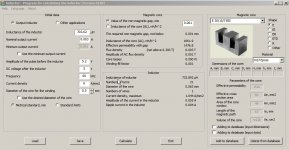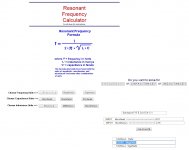obiwan
New member
Hello friends ! I have many different E , EI , ER, R cores from different manufacturers I bought sometime.
These cores are kept grouped in the same bags and boxes the day I bought them, so no mix up possible.
But they don't have any inscription, code, part no. , model, etc.
I need to determine mu permeability by using a simple method.
Earlier today I took one E 30/15/7 no gap , and calculated an inductor using the Excellent 7300 program from Starichok51
Proposed L = 703 uH
Frequency f = 60KHz
N = 21 turns
The program input/output as follows:

I connected a 0.01 uF known value ceramic capacitor in parallel with the coil, applied a 60 KHz low level sine wave to this circuit and monitored on my scope.
With these values of L and C , the circuit showed perfect resonance at 60 KHz with maximum amplitude of the sine wave.

Then used the formula:
u = L / Lo
... where L is the value of the inductance using the core , Lo is the value of the inductance without the core (air core)
The value of the air core resonance occurred at 954.55 KHz that means L = 2.78 uH , so

u = 703 uH / 2.78 uH = 252.8
I find that this must be wrong. When I bought these cores the material was Epcos N27 and u should be arround 1500.
So I am doing something wrong here, or the formula or method is not correct.
Could you please enlighten me !
Thank you.
These cores are kept grouped in the same bags and boxes the day I bought them, so no mix up possible.
But they don't have any inscription, code, part no. , model, etc.
I need to determine mu permeability by using a simple method.
Earlier today I took one E 30/15/7 no gap , and calculated an inductor using the Excellent 7300 program from Starichok51
Proposed L = 703 uH
Frequency f = 60KHz
N = 21 turns
The program input/output as follows:

I connected a 0.01 uF known value ceramic capacitor in parallel with the coil, applied a 60 KHz low level sine wave to this circuit and monitored on my scope.
With these values of L and C , the circuit showed perfect resonance at 60 KHz with maximum amplitude of the sine wave.

Then used the formula:
u = L / Lo
... where L is the value of the inductance using the core , Lo is the value of the inductance without the core (air core)
The value of the air core resonance occurred at 954.55 KHz that means L = 2.78 uH , so

u = 703 uH / 2.78 uH = 252.8
I find that this must be wrong. When I bought these cores the material was Epcos N27 and u should be arround 1500.
So I am doing something wrong here, or the formula or method is not correct.
Could you please enlighten me !
Thank you.
